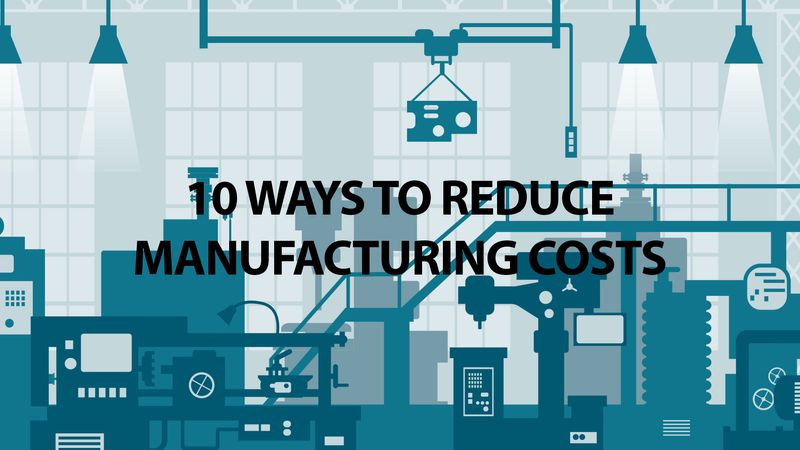10 Ways To Reduce Manufacturing Costs
When times are hard and profits are slim, many business owners look for ways to reduce manufacturing costs in their facility, without compromising product quality or endangering jobs. Here, we'll take a look at ten of the most effective ways to lower those costs.

10 Ways To Reduce Manufacturing Costs
This article was first published on
www.rowse.co.uk1. Audit Your Facility
The first thing to do when you're considering how to reduce your manufacturing costs is to make sure you know exactly what they are. Carry out an audit of all your key operating costs, and track them for a set period. Assess what might be eliminated by limiting administrative costs and managing debt. Look also at how much you're paying for overheads, such as building maintenance, rent, utilities, insurance coverage, office supplies and other incidentals.
2. Reduce The Direct Cost of Materials
You may be able to reduce costs by searching out more competitive suppliers for your materials. If you can't find a cheaper supplier, you might be able to negotiate a longer-term contract to get a lower unit price. Bulk discounts are sometimes offered if your business substantially increases your supplier's annual turnover or revenues, and some suppliers may offer discounts if you pay promptly, or in cash.
3. Evaluate Production Processes
Look at the way your product is made and get rid of any processes that are excessively time-consuming or redundant. You'll need to break down each individual step of the production cycle and track how long each step takes, consulting where necessary with staff who are using specific equipment or performing particular tasks. Keeping all machinery in tip-top condition helps reduce downtime, so you should focus on predictive or pre-emptive maintenance programmes. Routine maintenance can be carried out during slack periods to maximise time efficiency.
4. Restructure Your Product
You might also consider using fewer or cheaper base materials for your product, if you can do this without significantly impacting quality. Streamline your product by doing away with any features that don't contribute directly to its ultimate market appeal.
5. Cut Out Surplus
Subsidiary materials, such as documentation and packaging, may also be reduced. Excess packaging is not only wasteful and often damaging to the environment, but adds to the overall weight of the item, and therefore increases shipping costs. Try and convert your documentation processes to paperless applications, reducing your consumption of printers, inks, and copying facilities, as well as the paper itself.
6. Cut Shipping Costs
Assess how much time and fuel is used bringing in raw materials and delivering finished goods. You may able to adjust delivery routes to optimise travel time or reduce distances, and thus increase the number of daily shipments. If you sub-contract shipping, find a transport company who will also undertake the loading and unloading. See if you can negotiate a long-term contract with a competitively priced firm, preferably a local or non-brand company.
7. Optimise Workforce Efficiency
Start by getting involved with your workforce and motivating them as a team, sharing goals and successes so they feel invested in the business. Employee efficiency can be enhanced by training them in how to work at a faster rate. You can offer incentives to workers who cut the average unit production time. Make sure that workers' particular skills are more closely matched to their assigned tasks. New technology will also assist, but staff must be properly trained in its use.
8. Reduce Energy Consumption
Carry out an audit of your operating machinery and the general workflow, to see if there are times when less energy is required. Cut down wherever possible on unnecessary energy demands, such as air conditioning and any other electrical equipment that can be switched off when not in use. If possible, install an automated control system to optimise energy use.
9. Streamlining
If you produce more than you need, it will cost you to store it – and if the market is saturated, you may have to drop your prices to get rid of it. Beef up your quality control so that there is less spoilage, and less time wasted in redoing poor workmanship. If your facility generates scrap, firstly, see how this might be reduced. If that's not feasible, consider whether it might be recycled or sold on. You can also spring-clean your facility – look at all unused or surplus equipment, from office furniture to obsolete machinery, and see if anything can be resold.
10. Smart Investments
Upgrading tools and machinery can help to reduce manufacturing costs, and will deliver long-term benefits. Careful analysis needs to be carried out on the projected returns on capital purchases, assessing what cost benefits can be achieved before making a large investment. In some cases, it pays to wait, as technology advances at a rate where newer equipment quickly supersedes the old, especially in software.
Cutting costs without cutting corners is a delicate process, but with these ideas on how to reduce manufacturing costs, you should be able to fine-tune your business expenditure.